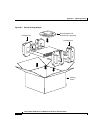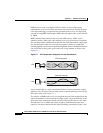
C-1
Catalyst 2984G, 2948G-GE-TX, and 2980G Switch Hardware Installation Guide
78-6286-05
APPENDIX
C
Differential Mode Delay
When an unconditioned laser source designed for operation on a single-mode
fiber (SMF) cable is directly coupled to a multimode fiber (MMF) cable,
differential mode delay (DMD) might occur. DMD can degrade the modal
bandwidth of the fiber-optic cable. This degradation causes a decrease in the link
span (the distance between the transmitter and the receiver) that can be reliably
supported.
The Gigabit Ethernet specification (IEEE 802.3z) outlines parameters for
Ethernet communications at a gigabit-per-second rate. The specification describes
a higher-speed version of Ethernet for backbone and server connectivity using
existing deployed MMF cable. It does this by defining the use of laser-based
optical components to propagate data over MMF cable.
Lasers function at the baud rates and longer distances required for Gigabit
Ethernet. The IEEE 802.3z Gigabit Ethernet Task Force has identified the DMD
condition that occurs in certain circumstances with particular combinations of
lasers and MMF cable. The resulting characteristics create an additional element
of jitter, which limits the reach of Gigabit Ethernet over MMF cable.
When DMD occurs, a single laser light pulse excites a few modes equally within
an MMF cable. These modes, or light pathways, then follow two or more different
paths. The paths might have different lengths and transmission delays as the light
travels through the cable. When DMD occurs, a distinct pulse propagating down
the cable no longer remains distinct or, in extreme cases, might become two
independent pulses. Strings of pulses tend to interfere with each other, making it
difficult to recover data in a reliable fashion.


















